Sara Pacchiarotti, postdoctoral research within the BantuFirst project, has a new book out in the prestigious “Stanford Monographs in African Languages” series published by The University of Chicago Press. Its title is Bantu Applicative Constructions .
Category: Events
Wannes Hubau publishes in Nature
Nature published on March 5, 2020 groundbreaking research from Wannes Hubau, postdoctoral researcher within the BantuFirst project, and his colleagues from a former project on the rates at which forests in Africa and Amazonia have taken up carbon between 1983 and 2015.
Job offer for a postdoctoral researcher in African Archaeology
The BantuFirst project is in search of a postdoctoral researcher in African Archaeology. Applications are invited here.
More than just words: A celebration of southern African languages on the occasion of the UNESCO Year of the Indigenous Languages
On November 11-13, 2019 Sara Pacchiarotti participated in the interdisciplinary conference “More than just words: A celebration of southern African languages on the occasion of the UNESCO Year of the Indigenous Languages” organized by Dr. Anne-Maria Fehn in close collaborations with African partners (San Research Center at the University of Botswana) and hosted at the CIBIO-InBIO lab in Vairão (Portugal). The conference brought together people from linguistics, cultural anthropology and the biological sciences, including speakers of Khoisan languages and Bantu languages from Botswana, Namibia and Angola, in order to highlight the importance of indigenous languages and indigenous knowledge in research and biodiversity conservation. Sara Pacchiarotti presented a talk in co-authorship with Koen Bostoen titled “Contact between non-Bantu speaking autochthonous hunter-gatherers and Bantu speakers in Central Africa: New linguistic insights from the BantuFirst Project”.
Heidi Goes presents her ongoing PhD research in Cabinda
On October 25, 2019, Heidi Goes had the opportunity to present some of her research on the Kikongo Language Cluster (a discrete branch within West-Coastal Bantu) at the first-ever conference on the languages of Cabinda in Cabinda. She was the only foreign participant and attracted quite some media attention, amongst others from Jornal de Angola (November 3 issue).
.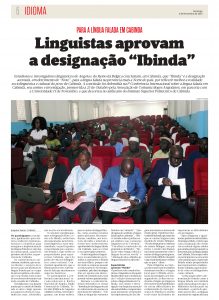
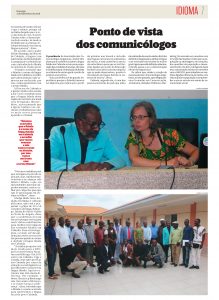
Linguistic, archaeological, and genetic fieldwork in the Kwilu province (DRC)
From August 10 to September 11 2019, Sara Pacchiarotti and Koen Bostoen conducted, together with Prof. Léon Mundeke (Kinshasa University), Prof. Igor Matonda (Kinshasa University) and Isidore Nkanu Ntsasa, linguistic, archaeological, and genetic fieldwork in the DRC. The fieldwork’s main objective was to explore the area of the new WCB homeland, which Pacchiarotti et al. (2019) located somewhere in between the Kamtsha and Kasai Rivers in the current DRC province of the Kwilu (roughly -3.50, 19-20).
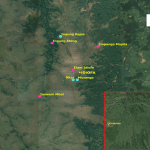
The initial goal was to reach the small towns of Panu (-3.79, 19.11) and Mangai (-4.02, 19.53), both located on the left bank of the Kasai River, approximately 600 kms northeast of Kinshasa (-4.32, 15.31). On our way to Panu, we stayed two days in Kikwit (-5.04, 18.81), where we started collecting genetic samples among university students at the Institut Supérieur Pédagogique in collaboration with Prof. Joseph Koni Muluwa. We then stopped in Idiofa (-4.96, 19.59) to split up the long journey. Our attempt to reach Panu and Mangai from Idiofa failed due to extremely poor road conditions and the impossibility to travel through hundreds of endless sandbanks with the vehicle we were using. As a consequence, the fieldwork team settled in Idiofa for approximately three weeks and conducted archaeological, linguistic and genetic fieldwork from this location.
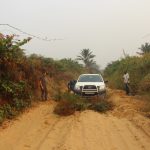
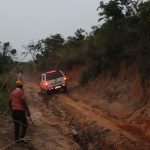
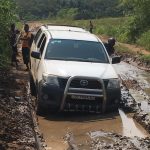
The archaeological fieldwork aimed at surveying and excavating in an area where excavations had never been conducted before in order to find datable traces of the first settlers and to start establishing a pottery-based cultural sequence. With the help of Isidore Nkanu Nsasa and local workers, Prof. Igor Matonda surveyed in Ingung Ateng (-4.89, 19.56), Impanga Mopila (-4.89, 19.65), Elom Idiofa (-4.96, 19.59), and Inswem Mbel (‑5.04, 19.51). He excavated in Ingung Kapia (-4.86, 19.56), Nkar (-4.98, 19.59), and Musanga (‑4.99, 19.58). He and his team excavated pottery from different time periods (both Early and Late Iron Age) in association with charcoal and iron slag. They also collected soil samples for future paleo-environmental research. In close connection to the archaeological fieldwork, an ethnographic survey was carried out on current-day pottery making in the village of Ingung Kapia. Prof. Léon Mundeke and Koen Bostoen videorecorded the entire chaîne opératoire and collected the specialized vocabulary related to the fashioning of pottery in Mbuun B87, the main Bantu language spoken in the area around Idiofa.
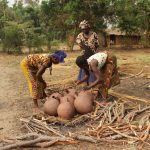
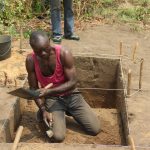

The linguistic fieldwork by Sara Pacchiarotti and Koen Bostoen primarily intended to collect data on Ngwi B861, a nearly undocumented and undescribed WCB variety spoken in several villages on the left bank of the Kasai River. Secondarily, we wanted to gather more lexical data on Lwel B862, spoken close to Ngwi B861, and on Mpe B821 and Nunu B822, two virtually unknown WCB languages spoken north of the Kwa River around the city of Mushie (-3.01, 16.92) and Nioki (-2.72, 17.69) in the Mai Ndombe Province. For Ngwi, we worked extensively with two consultants originally from Mangai but currently living in Idiofa, i.e. Mr. Fréderic Impenge Itobola and Mr. Eugene Marako Wosama. On the side, we also collected some lexical data on Lwel B862. Although we could not travel to Mushie or Nioki, once back in Kinshasa from Idiofa, we collected data on the noun class systems of Mpe and Nunu as well as novelty lexical data on these two unknown WCB varieties. Finally, we elicited extra data on the Teke variety Bwala B70z to fill in some gaps in the data that Flore Bollaert collected during her fieldwork in 2018 as part of her MA research.

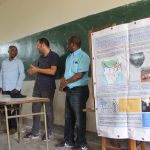
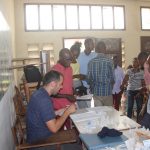
The genetic fieldwork aimed at collecting DNA samples from as many ethnolinguistic groups around the WCB homeland area as possible for further analysis at the Department of Organismal Biology at Uppsala University, under the supervision of Prof. Carina Schlebusch. The main goal is to get a better understanding of the population dynamics of the region’s ancestral Bantu-speaking populations and to detect possible admixture with autochthonous hunter-gatherers. We were able to collect 260 saliva samples from several different ethnolinguistic groups, mostly West-Coastal Bantu but also some Central Western and South Western Bantu. Prof. Léon Mundeke, Koen Bostoen and Sara Pacchiarotti conducted saliva sampling in Kikwit, Idiofa, Mangai, and Kinshasa.
Peopling History of Africa: A Multidisciplinary Perspective
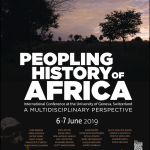 On June 6-7 Koen Bostoen and Sara Pacchiarotti attended the “Peopling History of Africa: A Multidisciplinary Perspective” conference in Geneva (Switzerland). They presented together the invited talk The first Bantu speakers south of the Equatorial Rainforest: preliminary new evidence from historical linguistics and archaeology, including preliminary results from the linguistic and archaeological research carried out so far within the BantuFirst project. This conference was organized by Anne Mayor (Anthropology Unit) and Alicia Sanchez-Mazas (Department of Genetics and Evolution) of the University of Geneva and aimed at gathering a number of outstanding international researchers active in different fields in order to present a comprehensive view of our present knowledge about the peopling of Africa.
On June 6-7 Koen Bostoen and Sara Pacchiarotti attended the “Peopling History of Africa: A Multidisciplinary Perspective” conference in Geneva (Switzerland). They presented together the invited talk The first Bantu speakers south of the Equatorial Rainforest: preliminary new evidence from historical linguistics and archaeology, including preliminary results from the linguistic and archaeological research carried out so far within the BantuFirst project. This conference was organized by Anne Mayor (Anthropology Unit) and Alicia Sanchez-Mazas (Department of Genetics and Evolution) of the University of Geneva and aimed at gathering a number of outstanding international researchers active in different fields in order to present a comprehensive view of our present knowledge about the peopling of Africa.
Africa, the cradle of human diversity: Joining cultural and biological approaches to uncover African diversity
 On May 22-25 Koen Bostoen, Bernard Clist and Sara Pacchiarotti participated in the Conference “Africa, the cradle of human diversity: Joining cultural and biological approaches to uncover African diversity” in Uppsala (Sweden). The conference was organized by Carina Schlebusch (Associate Professor and leader of the Schlebusch, Human Evolution Program, Department of Organismal Biology, Uppsala University) and her team members Cesar Fortes-Lima (Postdoctoral researcher in Population Genetics), Ezekia Mtetwa (Researcher in Archaeogenomics) and Cécile Jolly (Research Engineer). Koen Bostoen presented the invited talk The first Bantu speakers south of the Central-African rainforest: New insights from historical linguistics and archaeology, which included results obtained within linguistics and archaeology after the first year of the BantuFirst project. Bernard Clist presented the invited talk West-Central African diversity from the Stone Age to the Iron Age, continuities and transitions during the last 10,000 years. Before the very start of the conference, Sara Pacchiarotti presented the invited talk Untangling the West-Coastal Bantu Mess: Identification, Geography and Phylogeny of the Bantu B50-80 Languages during a Mini-Workshop on African Linguistics. The conference was also an opportunity to coordinate imminent linguistic fieldwork with genetic sampling in the DRC. If all goes well, the latter will be conducted by Ezekia Mtetwa and Cécile Jolly.
On May 22-25 Koen Bostoen, Bernard Clist and Sara Pacchiarotti participated in the Conference “Africa, the cradle of human diversity: Joining cultural and biological approaches to uncover African diversity” in Uppsala (Sweden). The conference was organized by Carina Schlebusch (Associate Professor and leader of the Schlebusch, Human Evolution Program, Department of Organismal Biology, Uppsala University) and her team members Cesar Fortes-Lima (Postdoctoral researcher in Population Genetics), Ezekia Mtetwa (Researcher in Archaeogenomics) and Cécile Jolly (Research Engineer). Koen Bostoen presented the invited talk The first Bantu speakers south of the Central-African rainforest: New insights from historical linguistics and archaeology, which included results obtained within linguistics and archaeology after the first year of the BantuFirst project. Bernard Clist presented the invited talk West-Central African diversity from the Stone Age to the Iron Age, continuities and transitions during the last 10,000 years. Before the very start of the conference, Sara Pacchiarotti presented the invited talk Untangling the West-Coastal Bantu Mess: Identification, Geography and Phylogeny of the Bantu B50-80 Languages during a Mini-Workshop on African Linguistics. The conference was also an opportunity to coordinate imminent linguistic fieldwork with genetic sampling in the DRC. If all goes well, the latter will be conducted by Ezekia Mtetwa and Cécile Jolly.
Contested Millets in Africa and Asia: Past and Present
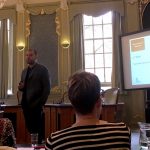 On March 28-29, 2019, Koen Bostoen, Sifra Van Acker and Sara Pacchiarotti participated in the International Workshop on “Contested Millets in Africa and Asia: Past and Present” in Groningen (Netherlands), which was organized by Peter Berger (University of Groningen) and Roland Hardenberg (Frobenius Institut für Kulturanthropologische Forschung an der Goethe-Universität Frankfurt). They presented an invited lecture titled “On the rise and fall of millets in Bantu speech communities of Central Africa: Insights from historical linguistics and archaeology“, which included preliminary results from Sifra’s ongoing historical-linguistic PhD research within the BantuFirst project.
On March 28-29, 2019, Koen Bostoen, Sifra Van Acker and Sara Pacchiarotti participated in the International Workshop on “Contested Millets in Africa and Asia: Past and Present” in Groningen (Netherlands), which was organized by Peter Berger (University of Groningen) and Roland Hardenberg (Frobenius Institut für Kulturanthropologische Forschung an der Goethe-Universität Frankfurt). They presented an invited lecture titled “On the rise and fall of millets in Bantu speech communities of Central Africa: Insights from historical linguistics and archaeology“, which included preliminary results from Sifra’s ongoing historical-linguistic PhD research within the BantuFirst project.
Equatorial Guinea: exploratory mission, November-December 2018
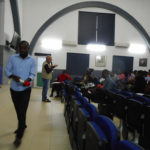 Subsequent to preliminary contacts with the National Center for Scientific Research of Equatorial Guinea (CICTE : Centro de Investigaciones Cientificas y Tecnologicas), Prof. Bernard Clist carried out in Malabo a one-week exploratory mission funded by the French Ministry for Foreign Affairs (26 November-2 December). The aim of this visit was to develop the Center’s interest in starting Iron Age archaeological research in conjunction with historical linguistic research, on Bioko Island in a first phase and later on on the mainland. The research project aims to uncover the very poorly understood cultural sequence of Bioko island which may have started off around 4,000-3,000 bp. This sequence is in direct relationship with the earliest expansion of Bantu speech communities and villages through Central Africa which the BantuFirst project is trying to identify south of the rainforest in the Democratic Republic of Congo around 2500 bp. In addition to fruitful meetings with the CICTE board of directors, Bernard Clist gave two conferences about our archaeological knowledge of the history of Equatorial Guinea, one at the French school, the other at the National University (see picture).
Subsequent to preliminary contacts with the National Center for Scientific Research of Equatorial Guinea (CICTE : Centro de Investigaciones Cientificas y Tecnologicas), Prof. Bernard Clist carried out in Malabo a one-week exploratory mission funded by the French Ministry for Foreign Affairs (26 November-2 December). The aim of this visit was to develop the Center’s interest in starting Iron Age archaeological research in conjunction with historical linguistic research, on Bioko Island in a first phase and later on on the mainland. The research project aims to uncover the very poorly understood cultural sequence of Bioko island which may have started off around 4,000-3,000 bp. This sequence is in direct relationship with the earliest expansion of Bantu speech communities and villages through Central Africa which the BantuFirst project is trying to identify south of the rainforest in the Democratic Republic of Congo around 2500 bp. In addition to fruitful meetings with the CICTE board of directors, Bernard Clist gave two conferences about our archaeological knowledge of the history of Equatorial Guinea, one at the French school, the other at the National University (see picture).
